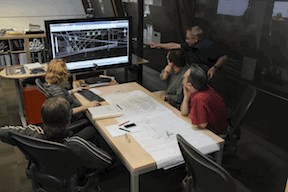How Can IPD Increase Efficiency and Profitability?

Imagine a world where owners, architects, designers, general contractors, consultants, and systems contractors gathered at the very beginning of a project, where decisions were collective, not top-down, where there was collaboration instead of confusion. Then imagine you wound up making more money than you’d originally planned. Sound like complete bunk?
To the proponents of IPD—Integrated Project Delivery—not at all. “IPD is supposed to take the collective knowledge and experience from all of the people that are going to work on the project, and pushes it up to the front of the project so that good decisions are made early,” explained Vance Breshears, director and principal at Acoustic Dimensions in San Diego, CA. The goal, he added, is for IPD to produce a better end result than traditional design/build or design/bid/build delivery methods do.

This means that the client holds more power over defining what ‘better end result’ actually means, and on IPD projects, it generally means fewer modifications along the way. “Typical contractors might bid the job as designed with a low price in order to improve their chances of winning the job, then count on change orders to improve their own profits,” illustrated Kevin Handerson, marketing director at Middle Atlantic Products. Under IPD, the building contractor works collaboratively with everyone else to ensure that the building is constructed as designed, with minimal risks or waste.
The problem with traditional delivery methods, Breshears argues, is that they put people at odds with one another. “There are, by design, adversarial relationships,” he said. They also require participants to play an unwieldy balancing act. For example, when a project is bid out, the goal is for the client to get the best product for the least amount of money, but oftentimes they receive the cheapest, but not necessarily the best, product. “For a contractor to be successful at playing the game, they have to cut corners and do the absolute minimum-quality work to complete the project, and that’s not in the client’s best interests.” IPD acts in the client’s best interests, and, if done right, provides the potential for key contractors and subcontractors to reap the benefits.
For IPD to work, however, everyone involved must be extremely dedicated to achieving the same goal: delivering the best possible product at maximum efficiency, with a strict commitment to reducing waste. While not all IPD projects involve incentive-based contracts, this is where they serve to ensure that everyone assumes this responsibility.
Breshears cites this case study of how these agreements work well: A client approached his team of engineers, consultants, the general contractor and the key subcontractors to inform them that he would not be bidding his project out. The only project elements that had been established were its size, what it needed to achieve functionally, and its $30 million budget—no design had yet taken place. The timeline was three years. If the project was delivered under budget and before the deadline, the client would keep 40 percent of the difference, with the remaining 60 percent being split up amongst the members of his team. The catch? Six months after project delivery, the occupants of the building would receive questionnaires to rate the building’s quality in all the key areas, such as design, lighting, plumbing, and so on. In order for everyone to receive this incentive, they had to score 75 percent or higher on the questionnaire.
“It turns out they finished it in two-and-a-half years,” Breshears recounted. “They did it for $26.5 million. Everybody got the financial incentive. The questionnaires came back, and they scored 90 percent on it. Everybody that worked on the project worked faster, more efficiently, they made more money, and the client got a better building in less time, for less cost.”
A daily selection of the top stories for AV integrators, resellers and consultants. Sign up below.
An encouraging story, for sure, but skeptics are right to be skeptical when they ask: Can I really trust my fellow team members that much? This is where systems contractors must rely on sharp instincts, past experience, and a little research. “Never get involved in an IPD project—or even a design/build project—where you don’t trust somebody in the first place,” cautioned Chuck Wilson, executive director of NSCA. “To me, the foundation in all of this is trust and mutual respect.” If you have had problems with someone on the team before, Wilson advised against signing on the dotted line. “Unless you have a huge amount of trust, stay away from this.”

One reason for this is the way that many IPD projects are structured, Wilson explained. “What happens is a partnership, or a limited liability corporation, is formed,” he said. “That job has a company that has been established to put it together: the owner, architect, and construction companies form an LLC with a P&L that everybody shares, and the gain and the losses derive from that.” Aligning everyone’s interests can be challenging, and this organizational structure often calls for a more elaborate insurance plan that includes errors and omissions—an added expense for the contractor—and it presents potential for trouble if one of the team members breaks the terms of the contract or goes out of business. Which, Wilson added, comes back to this issue of trust.
Handerson also believes that trust is a big issue, especially since the project’s key constituents are selected prior to any design. “This in itself can be a significant challenge—it means that the installing contractor is not selected by a traditional bid process on the finished design. Instead, the contractor might be chosen based on, for example, their experience and capabilities with jobs of similar scope,” he said. Not only can it be difficult for the owner to accept and trust a contractor; it can also be difficult for a contractor to agree to work on a job before having a clear idea of the scope of work.
Another issue is determining how project information will be shared amongst collaborators. In the past, paper drawings were circulated between designers and contractors; today, many favor collaborative software and various tools such as revision tracking and electronic mark-ups and comments to boost efficiency and cut down on miscommunication. Handerson noted that one of the most significant advances is Building Information Modeling (BIM), which offers team members to create a three-dimensional prototype of the building before ground is broken. Handerson—whose company offers BIM models of a number of its products—noted that manufacturers have an important role to play in this area.
While IPD remains a relatively new concept in the AV integration industry, Wilson encourages systems contractors to start preparing for it by developing solid project management skills and a deep knowledge of contracts. “This is what is going to get you a seat at this table—that you have proven, over and over again, that you can turn in a project on time, on budget, without many change orders,” he said. In the IPD world, there aren’t a lot of change orders—if something is wrong, you have to fix it, because it’s part of your scope of work. “It’s a different mindset for contractors, and it’s one that is going to require a significant investment in the right people to get them at the level to be considered for an IPD job.”
Carolyn Heinze is a freelance writer/editor.
BIM… Or Bust?
Often associated with IPD, BIM (Building Information Modeling) is a design tool that can be applied regardless of the project’s delivery method. As clients continue to pressure their design and construction teams to cut costs, it is increasingly being used to create 3D models before any physical construction work begins.
“It’s a tool that’s emerged, and there is still a long way to go for BIM to be fully realized as far as its power,” said Vance Breshears, director and principal at Acoustic Dimensions in San Diego, CA. “But it’s happening, and people are starting to realize that building a prototype in software is more beneficial than building the prototype, physically, on the ground.” Because BIM enables team members to address issues in the design phase, he believes that it could potentially reduce costs. “When it’s fully realized, I think it will help people to make more money, because designs will become more automated and more efficient, in that if you touch a piece of information only one time, it’s much more efficient than having to touch that information in five, six, or seven different places.”
But for systems contractors, BIM can also present challenges—especially on bid projects. “A lot of our members bid their jobs so lean right now, they count on the change orders to be their primary profit,” said Chuck Wilson, executive director of NSCA. “BIM works against that.”
So, how can contractors integrate BIM into their processes, bid lean, and make it work to their advantage? “That’s the $100 question.”
—C.H.
Carolyn Heinze has covered everything from AV/IT and business to cowboys and cowgirls ... and the horses they love. She was the Paris contributing editor for the pan-European site Running in Heels, providing news and views on fashion, culture, and the arts for her column, “France in Your Pants.” She has also contributed critiques of foreign cinema and French politics for the politico-literary site, The New Vulgate.
